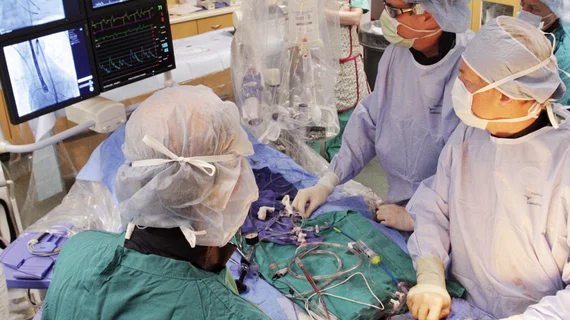Anticoagulants after TAVR: 5-year survival data favor DOACs over VKAs
When transcatheter aortic valve replacement (TAVR) patients require oral anticoagulation, vitamin K antagonists (VKAs) are associated with a higher five-year risk of all-cause mortality than direct oral anticoagulants (DOACs), according to new data published in JACC: Cardiovascular Interventions.[1]
However, treatment with VKAs appears to be linked to a lower risk of experiencing a disabling stroke.
“Studies comparing the safety and efficacy of DOACs and VKAs post-TAVR have yielded conflicting results,” wrote corresponding author Stefan Stortecky, MD, an interventional cardiologist with Bern University Hospital, and colleagues. “Moreover, comparative analyses of long-term outcome data associated with the two oral anticoagulation regimens in this patient population are scarce. The debate on the OAC choice is gaining increasing attention with the declining risk profile and increasing life expectancy of patients undergoing TAVR.”
Stortecky et al. examined data from more than 10,000 patients who underwent transfemoral TAVR in Switzerland from February 2011 to June 2021. While 14.5% of patients were prescribed VKAs at discharge, 21.5% were prescribed DOACs. The authors performed propensity score matching to land on a final analysis of 1,454 patients from each group.
All baseline patient characteristics between the two groups were similar after propensity score matching, with two exceptions; VKA patients still had a lower mean left ventricular ejection fraction (52.8% vs. 54.6%) and higher mean Surgery of Thoracic Surgeons Predicted Risk of Mortality score (5.5 vs. 4.7).
Clinical outcomes up to 5 years after TAVR
After just 30 days, there was “no significant difference” between patients treated with VKA and DOAC. However, VKAs were associated with a higher mortality rate (14.8% vs. 11.2%) and myocardial infarction rate (0.6% vs. 0.2%) than DOACs after one year. Clinical outcomes were otherwise comparable at that one-year mark.
After five years, VKAs were still associated with a higher mortality rate (59.8% vs. 50.1%). In addition, being prescribed oral anticoagulants—VKAs or DOACs—was found to be an independent predictor of all-cause mortality after five years.
Another noteworthy takeaway from the team’s analysis was the fact that a history of percutaneous coronary intervention or myocardial infarction appeared to be an independent predictor for all-cause mortality among patients in the VKA group, but not those in the DOAC group.
While some of these statistics appear to favor treatment with DOACs, Stortecky and colleagues did find that the rate of disabling strokes was significantly higher among patients prescribed DOACs after five years.
“Although this finding should be interpreted with caution, it is important and of potential relevance to patients of low-risk profile and high life expectancy, especially as some studies have raised concerns about the thromboembolic risk profile of DOACs after both mechanical and bioprosthetic valve replacement,” the authors wrote.
In fact, the group continued, the disabling stroke data help emphasize that there are certain advantages to both treatment options.
“Our data suggest that the improved survival seen with the use of DOACs compared with VKAs should be balanced against the increased risk for stroke and potentially an impaired quality of life as a consequence of stroke,” they wrote. “Patient priorities, concerns, and desired quality of life should be at the heart of the discussion about the choice of oral anticoagulant regimen.”
Click here to read the full analysis.

